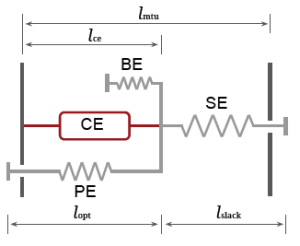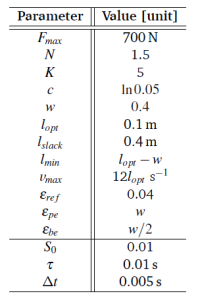Dies ist eine alte Version des Dokuments!
Inhaltsverzeichnis
Neuromuscular modeling
Author: Guoping Zhao, Lauflabor (www.lauflabor.de), TU Darmstadt, Germany
Date: July, 2019
This wiki shows how to build a Hill-type neuromuscular model in simulation.
Hill-type muscle model
Figure 1: Muscle-tendon unit (MTU) model. CE, BE, PE and SE denote contractile element, buffer elasticity, parallel elasticity, and series elasticity, respectively.
The Hill-type muscle-tendon unit (MTU) model (Geyer2010) is used in this paper. The MTU consists of a series elasticity (SE), a contractile element (CE), a parallel elasticity (PE), and a buffer elasticity (BE). The generated CE force $F_{ce}$ is computed by the muscle activation ($A$), maximum isometric force $F_{max}$, force-length ($f_l$) and force-velocity ($f_v$) relationships of the CE (Geyer2010, Geyer2003): \begin{equation} \label{eqn_fce} F_{ce} = A F_{max} f_{l}\left(l_{ce}\right) f_v\left(v_{ce}\right) \end{equation} \begin{equation} \label{eqn_fl} f_{l}\left(l_{ce}\right) = \exp\left(c\left| \frac{l_{ce}-l_{opt}}{l_{opt}w} \right|\right) \end{equation} \begin{equation} \label{eqn_fv} f_{v}\left(v_{ce}\right) = \left\{ \begin{array}{lr} \frac{v_{max}-v_{ce}}{v_{max}+Kv_{ce}} & v_{ce} < 0\\ N + \left(N-1\right) \frac{v_{max}-v_{ce}}{7.56Kv_{ce}-v_{max}} & v_{ce} \ge 0 \end{array} \right. \end{equation} where negative CE velocity $v_{ce}$ denotes the concentric movement. The width $w$ and residual force factor $c$ define the shape of $f_l$. The eccentric force enhancement $N$ and the shape factor $K$ define the $f_v$. The MTU force $F_{m}$ can be computed as \begin{equation} \label{eqn_fmtu} F_{m} = F_{se} = F_{ce} + F_{pe} - F_{be} \end{equation} where \begin{equation} \label{eqn_fse} F_{se} = \left\{ \begin{array}{lr} F_{max} \left(\frac{l_{se}/l_{slack}-1}{\varepsilon_{ref}}\right)^2 & l_{se}>l_{slack} \\ 0 & l_{se} \leq l_{slack} \end{array} \right. \end{equation} \begin{equation} \label{eqn_fpe} F_{pe} = F_{max}\left(\frac{l_{ce}-l_{opt}}{l_{opt}\varepsilon_{pe}}\right)^2 \end{equation} \begin{equation} \label{eqn_fbe} F_{be} = F_{max}\left(\frac{l_{min}-l_{ce}}{l_{opt}\varepsilon_{be}}\right)^2 \end{equation} where $l_{se}$ is the SE length, $l_{slack}$ is the SE rest length, $\varepsilon_{ref}$ is the reference strain of the SE, $\varepsilon_{pe}$ is the reference strain of the PE, $l_{opt}$ is the optimum length, $l_{min}$ is the BE rest length, $\varepsilon_{be}$ is the BE reference strain All the parameter values are listed in the following table.


